The Kernosovskiy idol, discovered in 1973 in Kernosovka (Kernosivka) and dated to the middle of the third millennium BC and associated with the late Pit Grave (Yamna) culture
Proto-Indo-European mythology is the body of myths and stories associated with the Proto-Indo-Europeans, the hypothetical speakers of the reconstructed Proto-Indo-European language. Although these stories are not directly attested, they have been reconstructed by scholars of comparative mythology based on the similarities in the belief systems of various Indo-European peoples.
Various schools of thought exist regarding the precise nature of
Proto-Indo-European mythology, which do not always agree with each
other. The main mythologies used in comparative reconstruction are Vedic, Roman, and Norse, often supported with evidence from the Baltic, Celtic, Greek, Slavic, and Hittite traditions as well.
The Proto-Indo-European pantheon includes well-attested deities such as *Dyḗus Pḥatḗr, the god of the daylit skies, his daughter *Haéusōs, the goddess of the dawn, the divine twins, and the storm god *Perkwunos. Other probable deities include *Péh2usōn, a pastoral god, and *Seh2ul, a female solar deity.
Well-attested myths of the Proto-Indo-Europeans include a myth involving a storm god
who slays a multi-headed serpent that dwells in water and a creation
story involving two brothers, one of whom sacrifices the other to create
the world. The Proto-Indo-Europeans may have believed that the Otherworld was guarded by a watchdog and could only be reached by crossing a river. They also may have believed in a world tree,
bearing fruit of immortality, either guarded by or gnawed on by a
serpent or dragon, and tended by three goddesses who spun the thread of
life.
Methods of reconstruction
Schools of thought
Portrait of Friedrich Max Müller, a prominent early scholar on the reconstruction of Proto-Indo-European religion and a proponent of the Meteorological School
The mythology of the Proto-Indo-Europeans is not directly attested
and it is difficult to match their language to archaeological findings
related to any specific culture from the Chalcolithic.
Nonetheless, scholars of comparative mythology have attempted to
reconstruct aspects of Proto-Indo-European mythology based on the
existence of similarities among the deities, religious practices, and myths of various Indo-European peoples. This method is known as the comparative method. Different schools of thought have approached the subject of Proto-Indo-European mythology from different angles.
The Meteorological School holds that Proto-Indo-European mythology was
largely centered around deified natural phenomena such as the sky, the Sun, the Moon, and the dawn. This meteorological interpretation was popular among early scholars, such as Friedrich Max Müller, who saw all myths as fundamentally solar allegories. This school lost most of its scholarly support in the late nineteenth and early twentieth centuries.
The Ritual School, which first became prominent in the late
nineteenth century, holds that Proto-Indo-European myths are best
understood as stories invented to explain various rituals and religious
practices. The Ritual School reached the height of its popularity during the early twentieth century. Many of its most prominent early proponents, such as James George Frazer and Jane Ellen Harrison, were classical scholars. Bruce Lincoln,
a contemporary member of the Ritual School, argues that the
Proto-Indo-Europeans believed that every sacrifice was a reenactment of
the original sacrifice performed by the founder of the human race on his
twin brother.
The Functionalist School holds that Proto-Indo-European society
and, consequently, their mythology, was largely centered around the trifunctional system proposed by Georges Dumézil, which holds that Proto-Indo-European society was divided into three distinct social classes: farmers, warriors, and priests. The Structuralist School, by contrast, argues that Proto-Indo-European mythology was largely centered around the concept of dualistic opposition.
This approach generally tends to focus on cultural universals within
the realm of mythology, rather than the genetic origins of those myths,
but it also offers refinements of the Dumézilian trifunctional system
by highlighting the oppositional elements present within each function,
such as the creative and destructive elements both found within the role
of the warrior.
Source mythologies
Scheme of Indo-European migrations from c. 4000 to 1000 BC according to the Kurgan hypothesis
One of the earliest attested and thus most important of all Indo-European mythologies is Vedic mythology, especially the mythology of the Rigveda, the oldest of the Vedas.
Early scholars of comparative mythology such as Friedrich Max Müller
stressed the importance of Vedic mythology to such an extent that they
practically equated it with Proto-Indo-European myth.
Modern researchers have been much more cautious, recognizing that,
although Vedic mythology is still central, other mythologies must also
be taken into account.
Another of the most important source mythologies for comparative research is Roman mythology.
Contrary to the frequent erroneous statement made by some authors that
"Rome has no myth", the Romans possessed a very complex mythological
system, parts of which have been preserved through the characteristic
Roman tendency to rationalize their myths into historical accounts. Despite its relatively late attestation, Norse mythology is still considered one of the three most important of the Indo-European mythologies for comparative research, simply due to the vast bulk of surviving Icelandic material.
Baltic mythology
has also received a great deal of scholarly attention, but has so far
remained frustrating to researchers because the sources are so
comparatively late.
Nonetheless, Latvian folk songs are seen as a major source of
information in the process of reconstructing Proto-Indo-European myth. Despite the popularity of Greek mythology in western culture, Greek mythology is generally seen as having little importance in comparative mythology due to the heavy influence of Pre-Greek and Near Eastern cultures, which overwhelms what little Indo-European material can be extracted from it. Consequently, Greek mythology received minimal scholarly attention until the mid 2000s.
Although Scythians are considered relatively conservative in regards to Proto-Indo-European cultures, retaining a similar lifestyle and culture, their mythology
has very rarely been examined in an Indo-European context and
infrequently discussed in regards to the nature of the ancestral
Indo-European mythology. At least three deities, Tabiti, Papaios and Api, are generally interpreted as having Indo-European origins,
while the remaining have seen more disparate interpretations. Influence
from Siberian, Turkic and even Near Eastern beliefs, on the other hand,
are more widely discussed in literature.
Pantheon
Linguists are able to reconstruct the names of some deities in the Proto-Indo-European language (PIE) from many types of sources. Some of the proposed deity names are more readily accepted among scholars than others.
The term for "a god" was *deiwos, reflected in Hittite: sius; Latin: deus, divus; Sanskrit: Dyaus, deva; Avestan: daeva (later, Persian, div); Welsh: duw; Irish: dia; Lithuanian: Dievas; Latvian: Dievs.
Heavenly deities
Sky Father
Laurel-wreathed head of Zeus on a gold stater from the Greek city of Lampsacus, c 360–340 BC
The head deity of the Proto-Indo-European pantheon was the god *Dyḗus Pḥatḗr, whose name literally means "Sky Father". He is believed to have been regarded as the god of the daylit skies. He is, by far, the most well-attested of all the Proto-Indo-European deities. The Greek god Zeus, the Roman god Jupiter, and the Illyrian god Dei-Pátrous all appear as the head gods of their respective pantheons. The Norse god Týr, however, seems to have been demoted to the role of a minor war-deity prior to the composition of the earliest Germanic texts. *Dyḗus Pḥatḗr is also attested in the Rigveda as Dyáus Pitā, a minor ancestor figure mentioned in only a few hymns. The names of the Latvian god Dievs and the Hittite god Attas Isanus do not preserve the exact literal translation of the name *Dyḗus Pḥatḗr, but do preserve the general meaning of it.
*Dyḗus Pḥatḗr may have had a consort who was an earth goddess. This possibility is attested in the Vedic pairing of Dyáus Pitā and Prithvi Mater, the Roman pairing of Jupiter and Tellus Mater from Macrobius's Saturnalia, and the Norse pairing of Odin and Jörð. Odin is not a reflex of *Dyḗus Pḥatḗr, but his cult may have subsumed aspects of an earlier chief deity who was. This pairing may also be further attested in an Old English ploughing prayer and in the Greek pairings of Ouranos and Gaia and Zeus and Demeter.
Dawn Goddess
Eos in her chariot flying over the sea, red-figure krater from South Italy, 430–420 BC, Staatliche Antikensammlungen, Munich
*Haéusōs has been reconstructed as the Proto-Indo-European goddess of the dawn. Twenty-one hymns in the Rigveda are dedicated to the dawn goddess Uṣás and a single passage from the Avesta honors the dawn goddess Ušå. The dawn goddess Eos appears prominently in early Greek poetry and mythology. The Roman dawn goddess Aurora is a reflection of the Greek Eos, but the original Roman dawn goddess may have continued to be worshipped under the cultic title Mater Matuta. The Anglo-Saxons worshipped the goddess Ēostre,
who was associated with a festival in spring which later gave its name
to a month, which gave its name to the Christian holiday of Easter in English. The name Ôstarmânôth in Old High German has been taken as an indication that a similar goddess was also worshipped in southern Germany. The Lithuanian dawn goddess Aušra was still acknowledged in the sixteenth century.
Uṣás in the Sanskrit tradition and Eos in the Greek have very similar
attributes, indicating that these attributes were established by at
least the Greco-Aryan period. Both goddesses are also portrayed as taking mortal lovers.
Sun and Moon
Possible depiction of the Hittite Sun goddess holding a child in her arms from between 1400 and 1200 BC
*Seh2ul and *Meh1not are reconstructed as the Proto-Indo-European goddess of the Sun and god of the Moon respectively. *Seh2ul is reconstructed based on the Greek god Helios, the Roman god Sol, the Celtic goddess Sul/Suil, the North Germanic goddess Sól, the Continental Germanic goddess *Sowilō, the Hittite goddess "UTU-liya", the Zoroastrian Hvare-khshaeta, and the Vedic god Surya.
*Meh1not- is reconstructed based on the Norse god Máni, the Slavic god Myesyats, and the Lithuanian god *Meno, or Mėnuo (Mėnulis). They are often seen as the twin children of various deities, but in fact the sun and moon were deified several times and are often found in competing forms within the same language.
The usual scheme is that one of these celestial deities is male and the other female, though the exact gender of the Sun or Moon tends to vary among subsequent Indo-European mythologies. The original Indo-European solar deity appears to have been female, a characteristic not only supported by the higher number of sun goddesses in subsequent derivations (feminine Sól, Saule, Sulis, Étaín, Grían, Aimend, Áine, and Catha versus masculine Helios, Surya, Savitr, Usil, and Sol) (Hvare-khshaeta is of neutral gender),
but also by vestiges in mythologies with male solar deities (Usil in
Etruscan art is depicted occasionally as a goddess, while solar
characteristics in Athena and Helen of Troy still remain in Greek mythology). The original Indo-European lunar deity appears to have been masculine,
with feminine lunar deities like Selene, Minerva, and Luna being a
development exclusive to the eastern Mediterranean. Even in these
traditions, remnants of male lunar deities, like Menelaus, remain.
Although the sun was personified as an independent, female deity,
the Proto-Indo-Europeans also visualized the sun as the eye of *Dyḗus Pḥatḗr, as seen in various reflexes: Helios as the eye of Zeus, Hvare-khshaeta as the eye of Ahura Mazda, and the sun as "God's eye" in Romanian folklore. The names of Celtic sun goddesses like Sulis and Grian
may also allude to this association; the words for "eye" and "sun" are
switched in these languages, hence the name of the goddesses.
Divine Twins
Horse Twins
Pair of Roman statuettes from the third century AD depicting the Dioscuri as horsemen, with their characteristic skullcaps (Metropolitan Museum of Art, New York)
The Horse Twins are a set of twin brothers found throughout nearly every Indo-European pantheon who usually have a name that means 'horse' *ekwa-, but the names are not always cognate and no Proto-Indo-European name for them can be reconstructed. In most Indo-European pantheons, the Horse Twins are brothers of the Sun Maiden or Dawn goddess, and sons of the sky god.
They are reconstructed based on the Vedic Ashvins, the Lithuanian Ašvieniai, the Latvian Dieva deli, the Greek Dioskouroi (Kastor and Polydeukes), the Roman Dioscuri (Castor and Pollux), and the Old English Hengist and Horsa (whose names mean "stallion" and "horse"). References from the Greek writer Timaeus indicate that the Celts may have had a set of horse twins as well. The Welsh Brân and Manawydan may also be related. The horse twins may have been based on the morning and evening star (the planet Venus)
and they often have stories about them in which they "accompany" the
Sun goddess, because of the close orbit of the planet Venus to the sun.
Twin Founders
The Proto-Indo-European Creation myth seems to have involved two key figures: *Manu- ("Man"; Indic Manu; Germanic Mannus) and his twin brother *Yemo- ("Twin"; Indic Yama; Germanic Ymir). Reflexes of these two figures usually fulfill the respective roles of founder of the human race and first human to die.
Storm deities
Ancient Gallo-Roman statue of the storm-god Taranis, clutching a wheel and thunderbolt, from Le Chatelet, Gourzon, Haute-Marne, France
*Perkwunos
has been reconstructed as the Proto-Indo-European god of lightning and
storms. His name literally means "The Striker." He is reconstructed
based on the Norse goddess Fjǫrgyn (the mother of Thor), the Lithuanian god Perkūnas, and the Slavic god Perúnú. The Vedic god Parjánya may also be related, but his possible connection to *Perkwunos is still under dispute. The name of *Perkwunos may also be attested in Greek as κεραυνός (Keraunós), an epithet of the god Zeus meaning "thunder-shaker." A possible alternative name, through the root *(s)tenh₂, is responsible for Thor as well as Hittite Tarhunt and Celtic Taran/Taranis. The Roman god Mars is also a speculated descendent, since he originally had thunderer characteristics.
Water deities
Some authors have proposed *Neptonos or *H2epom Nepōts as the Proto-Indo-European god of the waters. The name literally means "Grandson [or Nephew] of the Waters." Philologists reconstruct his name from that of the Vedic god Apám Nápát, the Roman god Neptūnus, and the Old Irish god Nechtain. Although such a god has been solidly reconstructed in Proto-Indo-Iranian religion, Mallory and Adams nonetheless still reject him as a Proto-Indo-European deity on linguistic grounds.
A river goddess *Dehanu- has been proposed based on the Vedic goddess Dānu, the Irish goddess Danu, the Welsh goddess Don and the names of the rivers Danube,
Don, Dnieper, and Dniester. Mallory and Adams, however, dismiss this
reconstruction, commenting that it does not have any evidence to support
it.
Some have also proposed the reconstruction of a sea god named *Trihatōn based on the Greek god Triton and the Old Irish word trïath,
meaning "sea." Mallory and Adams reject this reconstruction as having
no basis, asserting that the "lexical correspondence is only just
possible and with no evidence of a cognate sea god in Irish."
Nature deities
Two similar depictions of horned deities from the Celtic and Indic traditions
Detail from the Gundestrup cauldron from Gundestrup, Denmark, thought to date between 150 BC and 1 AD, showing the Celtic god Cernunnos with horns, sitting in a meditative position, surrounded by animals
The Pashupati seal from Mohenjo-daro in northern India, dated to between 2350 and 2000 BC, showing a horned, tricephelic deity in a meditative position, surrounded by animals
*Péh2usōn, a pastoral deity, is reconstructed based on the Greek god Pan and the Vedic god Pūshān. Both deities are closely affiliated with goats and were worshipped as pastoral deities.
The minor discrepancies between the two deities can be easily explained
by the possibility that many attributes originally associated with Pan
may have been transferred over to his father Hermes. The association between Pan and Pūshān was first identified in 1924 by the German scholar Hermann Collitz.
In 1855, Adalbert Kuhn
suggested that the Proto-Indo-Europeans may have believed in a set of
helper deities, whom he reconstructed based on the Germanic elves and the Hindu ribhus. Though this proposal is often mentioned in academic writings, very few scholars actually accept it. There may also have been a female cognate akin to the Greco-Roman nymphs, Slavic vilas, the Huldra of Germanic folklore, and the Hindu Apsaras.
Societal deities
Late second-century AD Greek mosaic from the House of Theseus at Paphos Archaeological Park on Cyprus showing the three Moirai: Klotho, Lachesis, and Atropos, standing behind Peleus and Thetis, the parents of Achilles
It is highly probable that the Proto-Indo-Europeans believed in three fate goddesses who spun the destinies of mankind. Although such fate goddesses are not directly attested in the Indo-Aryan tradition, the Atharvaveda does contain an allusion comparing fate to a warp. Furthermore, the three Fates appear in nearly every other Indo-European mythology. The earliest attested set of fate goddesses are the Gulses in Hittite mythology, who were said to preside over the individual destinies of human beings. They often appear in mythical narratives alongside the goddesses Papaya and Istustaya,
who, in a ritual text for the foundation of a new temple, are described
sitting holding mirrors and spindles, spinning the king's thread of
life. In the Greek tradition, the Moirai ("Apportioners") are mentioned dispensing destiny in both the Iliad and the Odyssey, in which they are given the epithet Κλῶθες (Klothes, meaning "Spinners"). In Hesiod's Theogony, the Moirai are said to "give mortal men both good and ill" and their names are listed as Klotho ("Spinner"), Lachesis ("Apportioner"), and Atropos ("Inflexible"). In his Republic, Plato records that Klotho sings of the past, Lachesis of the present, and Atropos of the future. In Roman legend, the Parcae
were three goddesses who presided over the births of children and whose
names were Nona ("Ninth"), Decuma ("Tenth"), and Morta ("Death"). They too were said to spin destinies, although this may have been due to influence from Greek literature.
In the Old Norse Völuspá and Gylfaginning, the Norns are three cosmic goddesses of fate who are described sitting by the well of Urðr at the foot of the world tree Yggdrasil. In Old Norse texts, the Norns are frequently conflated with Valkyries, who are sometimes also described as spinning. Old English texts, such as Rhyme Poem 70, and Guthlac 1350 f., reference Wyrd as a singular power that "weaves" destinies. Later texts mention the Wyrds as a group, with Geoffrey Chaucer referring to them as "the Werdys that we clepyn Destiné" in The Legend of Good Women. A goddess spinning appears in a bracteate from southwest Germany and a relief from Trier shows three mother goddesses, with two of them holding distaffs.
Tenth-century German ecclesiastical writings denounce the popular
belief in three sisters who determined the course of a man's life at his
birth.
An Old Irish hymn attests to seven goddesses who were believed to weave
the thread of destiny, which demonstrates that these spinster
fate-goddesses were present in Celtic mythology as well. A Lithuanian folktale recorded in 1839 recounts that a man's fate is spun at his birth by seven goddesses known as the deivės valdytojos and used to hang a star in the sky; when he dies, his thread snaps and his star falls as a meteor. In Latvian folk songs, a goddess called the Láima is described as weaving a child's fate at its birth. Although she is usually only one goddess, the Láima sometimes appears as three.
The three spinning fate goddesses appear in Slavic traditions in the
forms of the Russian Rožanicy, the Czech Sudičky, the Bulgarian
Narenčnice or Urisnice, the Polish Rodzanice, the Croatian Rodjenice,
the Serbian Sudjenice, and the Slovene Rojenice. Albanian folk tales speak of the Fatit, three old women who appear three days after a child is born and determine its fate, using language reminiscent of spinning.
Depiction of Wayland the Smith from the Franks Casket, dating to the eighth century AD
Although the name of a particular Proto-Indo-European smith god cannot be linguistically reconstructed,
it is highly probable that the Proto-Indo-Europeans had a smith deity
of some kind, since smith gods occur in nearly every Indo-European
culture, with examples including the Hittite god Hasammili, the Vedic
god Tvastr, the Greek god Hephaestus, the Germanic villain Wayland the Smith, and the Ossetian culture figure Kurdalagon.
Many of these smith figures share certain characteristics in common.
Hephaestus, the Greek god of blacksmiths, and Wayland the Smith, a
nefarious blacksmith from Germanic mythology, are both described as
lame. Additionally, Wayland the Smith and the Greek mythical inventor Daedalus both escape imprisonment on an island by fashioning sets of mechanical wings from feathers and wax and using them to fly away.
The Proto-Indo-Europeans may have had a goddess who presided over the trifunctional organization of society. Various epithets of the Iranian goddess Anahita and the Roman goddess Juno
provide sufficient evidence to solidly attest that she was probably
worshipped, but no specific name for her can be lexically reconstructed. Vague remnants of this goddess may also be preserved in the Greek goddess Athena.
Some scholars have proposed a war god *Māwort- based on the Roman god Mars and the Vedic Marutás, companions of the war-god Indra. Mallory and Adams, however, reject this reconstruction on linguistic grounds.
Likewise, some researchers have found it more plausible that Mars was
originally a storm deity, while this cannot be said for Ares.
Mythology
Dragon or serpent
The Hittite god Tarhunt, followed by his son Sarruma, kills the dragon Illuyanka (Museum of Anatolian Civilizations, Ankara, Turkey)
One common myth found in nearly all Indo-European mythologies is a battle ending with a hero or god slaying a serpent or dragon of some sort. Although the details of story often vary widely, in all iterations, several features remain remarkably the same. In iterations of the story, the serpent is usually associated with water in some way. The hero of the story is usually a thunder-god or a hero who is somehow associated with thunder. The serpent is usually multi-headed, or else "multiple" in some other way.
In Hittite mythology, the storm god Tarhunt slays the giant serpent Illuyanka. In the Rigveda, the god Indra slays the multi-headed serpent Vritra, which had been causing a drought. In the Bhagavata Purana, Krishna slays the serpent Kāliyā.
Greek red-figure vase painting depicting Heracles slaying the Lernaean Hydra, c. 375–340 BC
Several variations of the story are also found in Greek mythology as well. The story is attested in the legend of Zeus slaying the hundred-headed Typhon from Hesiod's Theogony, but it is also in the myths of the slaying of the nine-headed Lernaean Hydra by Heracles and the slaying of Python by Apollo. The story of Heracles's theft of the cattle of Geryon is probably also related.
Although Heracles is not usually thought of as a storm deity in the
conventional sense, he bears many attributes held by other Indo-European
storm deities, including physical strength and a knack for violence and
gluttony.
The original Proto-Indo-European myth is also reflected in Germanic mythology. In Norse mythology, Thor, the god of thunder, slays the giant serpent Jörmungandr, which lived in the waters surrounding the realm of Midgard. Other dragon-slaying myths are also found in the Germanic tradition. In the Völsunga saga, Sigurd slays the dragon Fafnir and, in Beowulf, the eponymous hero slays a different dragon.
Reflexes of the Proto-Indo-European dragon-slaying myth are found throughout other branches of the language family as well. In Zoroastrianism and Persian mythology, Fereydun, and later Garshasp, slays Zahhak. In Slavic mythology, Perun, the god of storms, slays Veles and Dobrynya Nikitich slays the three-headed dragon Zmey. In Armenian mythology, the god Vahagn slays the dragon Vishap. In Romanian folklore, Făt-Frumos slays the fire-spitting monster Zmeu. In Celtic mythology, Dian Cecht slays Meichi. The myth is believed to have symbolized a clash between forces of order and chaos. In every version of the story, the dragon or serpent always loses, although in some mythologies, such as the Norse Ragnarök myth, the hero or god dies as well.
Twin founders
The
analysis of different Indo-European tales indicates that the
Proto-Indo-Europeans believed there were two progenitors of mankind: *Manu- ("Man") and *Yemo- ("Twin"), his twin brother. A reconstructed creation myth involving the two is given by David W. Anthony, attributed in part to Bruce Lincoln:
Manu and Yemo traverse the cosmos, accompanied by the primordial cow,
and finally decide to create the world. To do so, Manu sacrifices either
Yemo or the cow, and with help from the sky father, the storm god and
the divine twins, forges the earth from the remains. Manu thus becomes
the first priest and establishes the practice of sacrifice. The sky gods
then present cattle to the third man, *Trito, who loses it to the three-headed serpent *Ngwhi,
but eventually overcomes this monster either alone or aided by the sky
father. Trito is now the first warrior and ensures that the cycle of
mutual giving between gods and humans may continue. Reflexes of *Manu include Indic Manu, Germanic Mannus; of Yemo, Indic Yama, Avestan Yima, Norse Ymir, possibly Roman Remus (earlier Old Latin *Yemos).
Ancient Roman relief from the Cathedral of Maria Saal showing the infant twins Romulus and Remus being suckled by a she-wolf
The early "history" of Rome is widely recognized as a historicized retelling of various old myths. Romulus and Remus are twin brothers from Roman mythology who both have stories in which they are killed.
The Roman writer Livy reports that Remus was believed to have been
killed by his brother Romulus at the founding of Rome when they entered
into a disagreement about which hill to build the city on. Later,
Romulus himself is said to have been torn limb-from-limb by a group of
senators. Both of these myths are widely recognized as historicized remnants of the Proto-Indo-European creation story.
The Germanic languages have information about both Ymir and Mannus (reflexes of *Yemo- and *Manu- respectively), but they never appear together in the same myth. Instead, they only occur in myths widely separated by both time and circumstances. In chapter two of his book Germania, which was written in Latin in around 98 A.D., the Roman writer Tacitus claims that Mannus, the son of Tuisto, was the ancestor of the Germanic peoples. This name never recurs anywhere in later Germanic literature, but one proposed meaning of the continental Germanic tribal name Alamanni is "Mannus' own people" ("all-men" being another scholarly etymology).
Fire in water
Another important possible myth is the myth of the fire in the waters, a myth which centers around the possible deity *H2epom Nepōts, a fiery deity who dwells in water. In the Rigveda, the god Apám Nápát is envisioned as a form of fire residing in the waters. In Celtic mythology, a well belonging to the god Nechtain is said to blind all those who gaze into it. In an old Armenian poem, a small reed in the middle of the sea spontaneously catches fire and the hero Vahagn springs forth from it with fiery hair and a fiery beard and eyes that blaze as suns. In a ninth-century Norwegian poem by the poet Thiodolf, the name sǣvar niþr, meaning "grandson of the sea," is used as a kenning for fire. Even the Greek tradition contains possible allusions to the myth of a fire-god dwelling deep beneath the sea. The phrase "νέποδες καλῆς Ἁλοσύδνης," meaning "descendants of the beautiful seas," is used in The Odyssey 4.404 as an epithet for the seals of Proteus.
Binding of evil
Jaan Puhvel notes similarities between the Norse myth in which the god Týr inserts his hand into the wolf Fenrir's mouth while the other gods bind him with Gleipnir, only for Fenrir to bite off Týr's hand when he discovers he cannot break his bindings, and the Iranian myth in which Jamshid rescues his brother's corpse from Ahriman's
bowels by reaching his hand up Ahriman's anus and pulling out his
brother's corpse, only for his hand to become infected with leprosy.
In both accounts, an authority figure forces the evil entity into
submission by inserting his hand into the being's orifice (in Fenrir's
case the mouth, in Ahriman's the anus) and losing it.
Fenrir and Ahriman fulfill different roles in their own mythological
traditions and are unlikely to be remnants of a Proto-Indo-European
"evil god"; nonetheless, it is clear that the "binding myth" is of Proto-Indo-European origin.
Cosmogony
In the cosmogonic myths of many Indo-European cultures a Cosmic Egg symbolizes the primordial state from which the universe arises.
Cosmology
Underworld
Attic red-figure lekythos attributed to the Tymbos painter showing Charon welcoming a soul into his boat, c. 500-450 BC
Most Indo-European traditions contain some kind of Underworld or Afterlife.
It is possible that the Proto-Indo-Europeans may have believed that, in
order to reach the Underworld, one needed to cross a river, guided by
an old man (*ĝerhaont-). The Greek tradition of the dead being ferried across the river Styx by Charon is probably a reflex of this belief. The idea of crossing a river to reach the Underworld is also present throughout Celtic mythologies. Several Vedic texts contain references to crossing a river in order to reach the land of the dead and the Latin word tarentum meaning "tomb" originally meant "crossing point." In Norse mythology, Hermóðr must cross a bridge over the river Giöll in order to reach Hel. In Latvian folk songs, the dead must cross a marsh rather than a river.
Traditions of placing coins on the bodies of the deceased in order to
pay the ferryman are attested in both ancient Greek and early modern
Slavic funerary practices.
It is also possible that the Proto-Indo-Europeans may have believed
that the Underworld was guarded by some kind of watchdog, similar to the
Greek Cerberus, the Hindu Śárvara, or the Norse Garmr.
World tree and serpent
The Proto-Indo-Europeans may have believed in some kind of world tree.
It is also possible that they may have believed that this tree was
either guarded by or under constant attack from some kind of dragon or
serpent. In Norse mythology, the cosmic tree Yggdrasil is tended by the three Norns while the dragon Nidhogg gnaws at its roots. In Greek mythology, the tree of the golden apples in the Garden of the Hesperides is tended by the three Hesperides and guarded by the hundred-headed dragon Ladon. In Indo-Iranian texts, there is a mythical tree dripping with Soma, the immortal drink of the gods and, in later Pahlavi sources, a malicious lizard is said to lurk at the bottom of it.




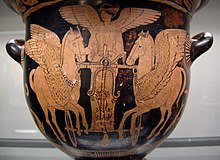
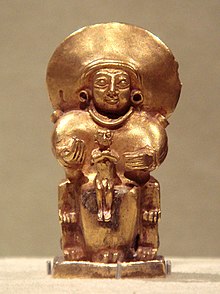
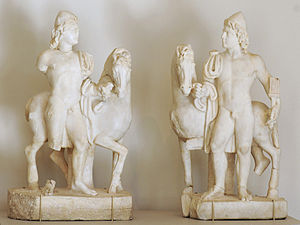
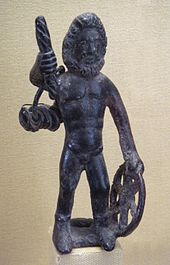






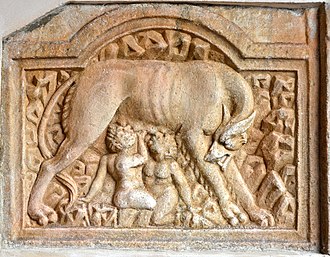

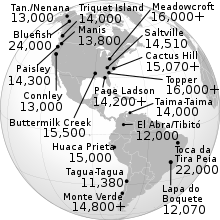
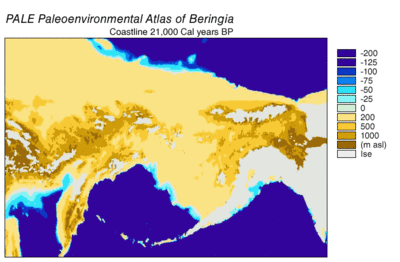
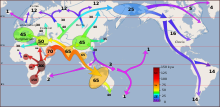

!["Maps depicting each phase of the three-step early human migrations for the peopling of the Americas. (A) Gradual population expansion of the Amerind ancestors from their Central East Asian gene pool (blue arrow). (B) Proto-Amerind occupation of Beringia with little to no population growth for ≈20,000 years. (C) Rapid colonization of the New World by a founder group migrating southward through the ice-free, inland corridor between the eastern Laurentide and western Cordilleran Ice Sheets (green arrow) and/or along the Pacific coast (red arrow). In (B), the exposed seafloor is shown at its greatest extent during the last glacial maximum at ≈20–18 kya [25]. In (A) and (C), the exposed seafloor is depicted at ≈40 kya and ≈16 kya, when prehistoric sea levels were comparable. A scaled-down version of Beringia today (60% reduction of A–C) is presented in the lower left corner. This smaller map highlights the Bering Strait that has geographically separated the New World from Asia since ≈11–10 kya."](https://upload.wikimedia.org/wikipedia/commons/thumb/d/d7/Journal.pone.0001596.g004.png/280px-Journal.pone.0001596.g004.png)
